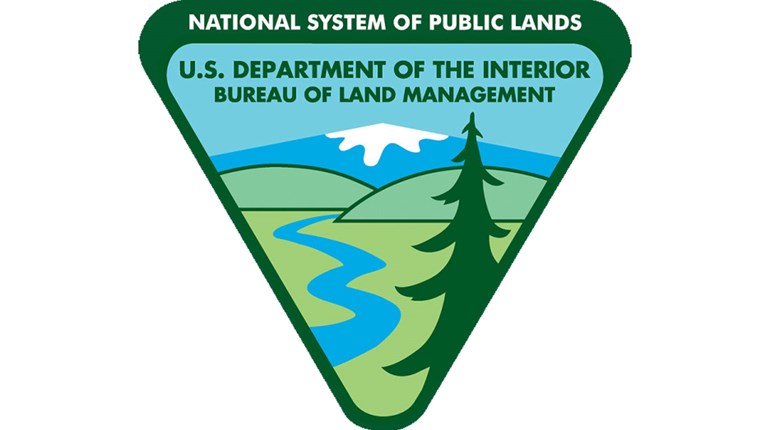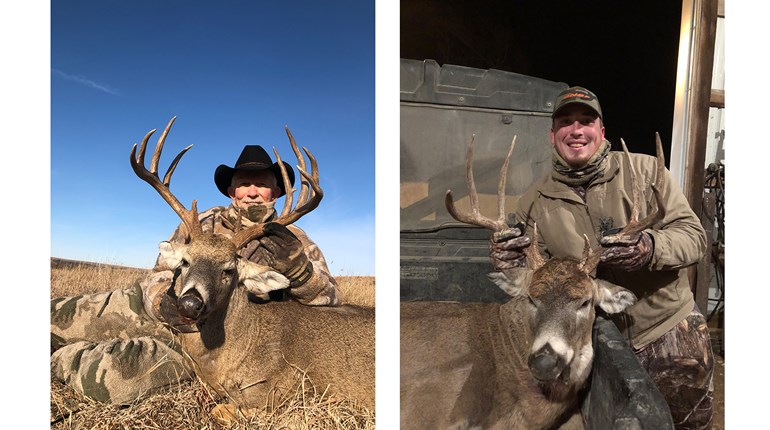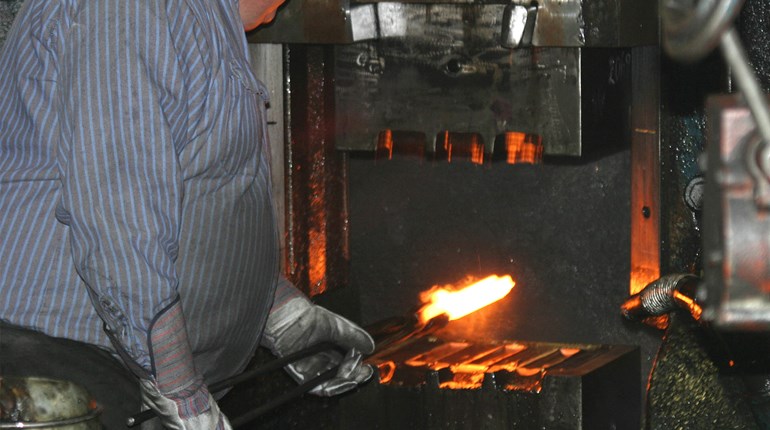
Cheyenne had worked a half mile of the rocky, low ridge before she nosed the south wind over the edge.
“She’s on to something,” I said to Bruce. “Let’s bail.” Dropping off the ridge wasn’t a major gravitational battle so much as a vegetative one. The tangle of shin-high brush, forbs and grasses was perfect hiding cover for sage grouse, distant cousin to the extinct heath hen and endangered Attwater’s prairie chicken and a candidate to join the threatened list itself.
And we were out to shoot one.
“She’s birdy all right,” Bruce said, readying his video camera. “Look at how she’s slowing down and tensing up.”
“Start filming,” I warned. “They should hold for a point, but could bust anytime.” Cheyenne struck her famous Heisman pose. We crunched our way closer, hearts pounding, palms sweating under the October sun. It had been more than 10 years since I’d taken a shot at North America’s largest grouse, several fruitless hunts suggesting the steep decline of this iconic Western gamebird was no joke. The wide-open, free-for-the-hunting public sage lands that had been grouse strongholds and a hunting paradise for decades were increasingly empty … until this moment on this tiny patch of sagebrush perfection in northeast Idaho.
The first bird flushed like a small turkey, right in front of my old setter’s never-fail nose, and my 20-gauge was at my shoulder and on the fleeing bird in an instant, guided by 50 years of muscle memory. At the pop of an ounce of No. 6 shot, the big bird tumbled, and I was done for the day. Bag limit: one.

One? A one-bird limit? Yes, and we were darn lucky to have it. In September 2015 we hunters dodged a bullet. Thanks to cooperative agreements and commitments from 11 Western states, from industry and from several federal government agencies—particularly the U.S. Fish & Wildlife Service—we narrowly missed having the sage grouse placed off-limits as an endangered species.
You read that correctly. The sage grouse, one of those native ground birds that once “darkened the sky,” is feared by some to be perched on the edge of oblivion. That’s crazy. From who-knows-how-many millions dancing and strutting along the Oregon Trail in 1850 to as few as 300,000 today, it’s been an insidious but major decline.
Say what you will about the Endangered Species Act and how it is often misused as a political hammer, but recognize that we hunters are short-changing ourselves, jeopardizing our hunting heritage and losing our upland bird hunting future if we ignore declining native grouse species like the sage grouse. While we rightly brag about the North American Model of Wildlife Conservation, a self-funded program that we hunters established—a program that has restored elk, pronghorns, whitetails, mountain lions, black and grizzly bears, turkeys, Canada geese, wood ducks and more—we have slowly, quietly let too many of our upland gamebirds slip away. Sage grouse, prairie chickens and sharptailed grouse in particular have disappeared from parts of the country where they were traditionally as common as meadowlarks—and even those songbirds have suffered serious declines, more evidence that a decline in habitat quality and abundance is driving this.

With these birds have gone millions of hunting days we no longer enjoy; millions in license revenues that could have, should have, improved habitat and produced more wildlife. We’ve lost millions in sales of shotguns, shotshells, boots, vests, dogs, dog food, e-collars and kennels. Millions of kids have grown up without knowing the adventure of weekend prowls of grasslands and grain fields, without the thrill of jumping birds that spike an adrenaline rush no computer game can match. Without our former abundance of upland gamebirds, we’ve deprived our children of a lifetime of exploration, exercise, shooting proficiency and joy. It is time that ended. It’s time we hunters did our part to restore upland gamebirds the way we restored wild turkeys, whitetails and even wolves. (That’s right, hunters largely made the reintroduction of wolves possible. If we hadn’t done the hard work of restoring elk, moose and deer populations, wolves would have nothing to kill and eat.)
Since 1995, wolf numbers in the Lower 48 have increased more than 20-fold! Imagine the hunting, the dog work, the shotgun sales, the camaraderie and the roast bird dinners if we could increase bird populations that much. Or even just 10-times. Heck, I and most veteran upland hunters who’ve seen the glory days would swoon with just a two-fold increase. Imagine how busy, how productive, how fun your autumn would be with millions of native grassland birds to hunt. Here’s a quick overview of what hunting could be like for several species.
Sage Grouse
Hundreds of millions of acres of Western sage lands remain in public ownership. That means you and I can hike, camp and hunt on them free of charge.
When September hunting seasons open, sage grouse are usually concentrated around remaining water, often cattle tanks, irrigation ditches or small reservoirs. Experienced hunters work within a few hundred yards of such water sources or the edges of irrigated pastures or alfalfa fields.

Later in the fall the birds begin migrating as many as 100 miles toward traditional wintering grounds.
Dogs aren’t necessary for locating these big grouse. You can often glass for them early in the mornings, spotting their heads above the low sage. Where numbers are high, it’s possible to just hike and stumble across them, but a dog’s nose can make any search more productive. Big-ranging pointing breeds can really cover country, saving you miles of fruitless walking.
An old cock bird might fatten up to 6 or 8 pounds, but look for the younger, more tender birds half that size. Forget the myths about sage grouse tasting like sagebrush with the texture of an old tire. Properly prepared (cleaned and chilled quickly, then grilled rare to medium rare like a good steak), sage grouse are tender, mild and delicious.
 Despite their size, sage grouse aren’t hard to bring down. Over the years I switched from heavy 12-gauge No. 4 shot loads to standard-weight 20-gauge loads and, quite often and satisfactorily, 28-gauge No. 6 shotshells. The birds usually flush in a ragged bunch with one or two often holding until you’ve fired a shot or two. Because these birds are large and somewhat exotic, most hunters get too excited, overreact and miss easy shots. Sage hens aren’t just idling along, but they don’t rocket to top speed like quail, either.
Despite their size, sage grouse aren’t hard to bring down. Over the years I switched from heavy 12-gauge No. 4 shot loads to standard-weight 20-gauge loads and, quite often and satisfactorily, 28-gauge No. 6 shotshells. The birds usually flush in a ragged bunch with one or two often holding until you’ve fired a shot or two. Because these birds are large and somewhat exotic, most hunters get too excited, overreact and miss easy shots. Sage hens aren’t just idling along, but they don’t rocket to top speed like quail, either.
Half the fun of a sage grouse hunt is just being in the incredibly vast country they call home. Chances are you can look to the long horizon and hike to it legally and unfettered, appreciating what the pioneers must have felt 150 years ago.
Prairie Chickens
Chickens are tall-grass prairie specialists formerly abundant from Ohio to Kansas. Corn and soybeans displaced them nearly everywhere except the western edges of tall-grass prairie from central South Dakota south through the Kansas Flint Hills. It’s dry or rocky enough in some of this region to dissuade farmers from plowing up the native grasslands. When about 50 percent of habitat remains in grass, the rest in mixed cereal grains, greater prairie chickens thrive.
They are found in family groups from late summer until about mid-October when they begin coalescing into large flocks. September hunts involve lots of walking. Birds are often found out of the wind just under hillcrests and ridgetops. They forage on native berries and soft forbs. Alfalfa fields also can be hotspots, especially if native grass is dry. At some point the birds will begin hitting grain fields, particularly milo, sunflowers and beans.

Big-running pointing dogs are the perfect match for prairie chickens. Turn them loose and enjoy the freedom. They’ll find birds soon enough. Light loads of No. 7 to No. 4 shot will suffice. The stronger the winds and the later the season, the wilder the birds will flush. Larger shot and tighter chokes then come into play.
The colder it gets—and especially if it snows—the more likely flocks will fly a mile or more from roosting shelter to feed fields. This is when many hunters wait under flight paths or even in blinds right in the fields. At this time of year it can be nigh impossible to approach within shotgun range of birds, even with dogs showing the way.
Other chickens are currently on the endangered species list: the Attwater’s in coastal Texas and the lesser chicken from southwest Kansas into New Mexico. The extinct heath hen, formerly found in open moors and bogs along the Atlantic Coast from southern New Hampshire to Virginia, was a close cousin to greater and lesser chickens. I’m guessing thousands of hunters in the East would love to have an annual heath hen season. This kind of loss is incalculable. Let’s not let it happen to the prairie chickens we still have.
Sharptails
Sharptailed grouse are close cousins to prairie chickens, but they’re more brush-loving. Denizens of bogs and sloughs in the Great Lakes states, their populations exploded after clear-cut logging long ago. Populations are spotty but persist, often in good numbers, from northern Michigan to Alaska, eastern Oregon to southern Nebraska. In Nebraska and South Dakota, they often intermingle with prairie chickens and even crossbreed from time to time. My best upland hunting “trophy” was getting to shoot a left-right double, prairie chicken and sharptail, from the same covey flush in South Dakota. How many people ever get to experience something like that?
 Like greater prairie chickens, sharptails in the grasslands fly to grain fields to feed. The later, windier and colder it gets, the wilder they get. Small coveys and family groups in September become big flocks by mid-October. Like sage grouse and chickens, early-season sharptails hold beautifully for dogs. In winter they often migrate 60 miles to find ideal habitat, usually brushy river bottoms where they can eat buds when ground vegetation and grain crops are buried under snow.
Like greater prairie chickens, sharptails in the grasslands fly to grain fields to feed. The later, windier and colder it gets, the wilder they get. Small coveys and family groups in September become big flocks by mid-October. Like sage grouse and chickens, early-season sharptails hold beautifully for dogs. In winter they often migrate 60 miles to find ideal habitat, usually brushy river bottoms where they can eat buds when ground vegetation and grain crops are buried under snow.
Sharptails have declined drastically in many locations. The Columbian subspecies in eastern Oregon and Washington and western Idaho was historically abundant but can no longer be hunted. When native habitats are abused, native birds suffer.
The same guns, chokes and shells ideal for chickens are perfect for sharpies. While a 20- or 28-gauge is deadly on young coveys in the warmth of mid-September, after mid-October 12-gauges and No. 5 or No. 4 shot are more effective. It isn’t unusual to flush one or two sharptails at 30 to 50 yards when walking up November ringneck pheasants in central South Dakota. Shooting a double with an open choke in one barrel, a tight choke in the other isn’t a bad idea.
Resurgence?
In mid-November 2015, I strode through a CRP grass field on the old family farm in eastern South Dakota, flushing pheasants. This was ringneck country when I was a boy in the Elvis era. It had been ringneck country when my mom was a girl in the Dust Bowl era. But it had been prairie chicken country when my grandpa was a lad. In all my life I’d never seen a prairie chicken here, nor had any members of my extended family. But this November day, with the wind screaming 25 mph out of the northwest, I surprised a greater prairie chicken sheltering in the switchgrass. One shot from my 20-gauge brought it down, a modern first that stands as a shining example of what could be. Enough CRP fields had been established to enable chickens to pioneer 60 miles farther east than they’d been in decades.
Just because we’ve changed the habitat that sage grouse, prairie chickens and sharptails need to thrive doesn’t mean we can’t reverse it. This isn’t rocket science, just good habitat recognition and establishment. Plant tall grasses and tall-grass grouse can live in it. Restore critical components of the sage steppe and sage grouse will again thrive. With farmers struggling to pay their taxes, beat the weather and turn a profit, we can’t expect them to convert half or even 10 percent of their corn and bean fields to switchgrass, but the success of our Conservation Reserve Program since 1985 proves we can help them restore some of it. In many cases, that can be enough. The general public, and especially the hunting public, benefits from land improvement, from a reduction in erosion and water pollution and an increase in wildlife. Perhaps they ought to help pay for it?
On public lands in the West, the Bureau of Land Management and Forest Service manage millions of acres we all own. We should be able to demand proper grazing levels, minimal road building and careful mineral extraction that minimizes habitat disturbance. We shouldn’t have to settle for business as usual, which has resulted in the once-abundant sage grouse nearly being listed as an endangered species.
It will be interesting to see if the management policies and agreements planned to restore sage grouse really work. As interested parties, we hunters should hold all government agencies, state and federal, to their agreements. We should thank private businesses and ranchers for agreeing to cooperate and encourage them to continue. With proper, careful and balanced management, there is hope that we can restore our native upland grouse as successfully as we’ve restored elk and turkeys.
In the meantime, we should all plan and execute hunts of our own for these grassland grouse species. The more of us who know and love these birds and the pursuit of them, the more support they will get. License and stamp fees will encourage wildlife managers to pay more attention to upland birds and habitats.
I’d like to think that someday my grandkids, grown and with kids of their own, will walk the sage steppe of eastern Idaho and say, “This is where Grandpa and his friends used to hunt sage grouse—but there weren’t as many as there are today!”




































